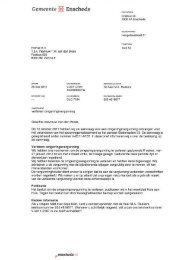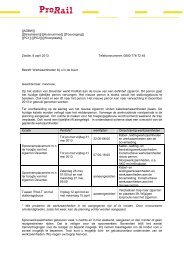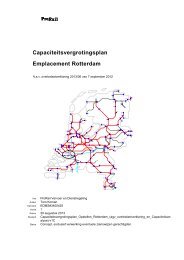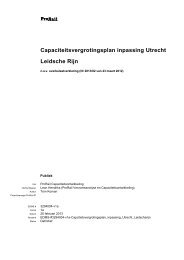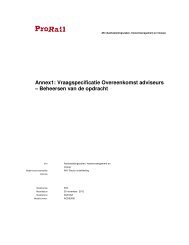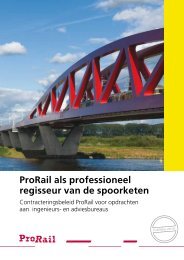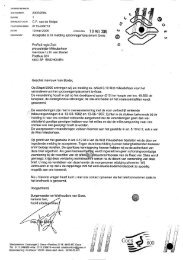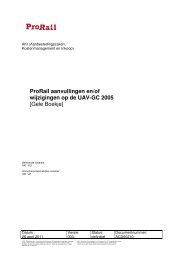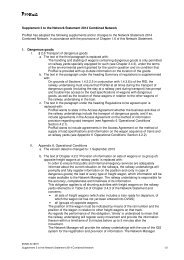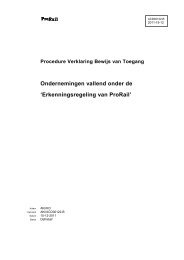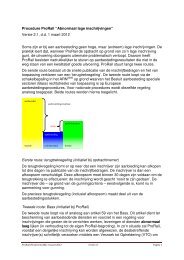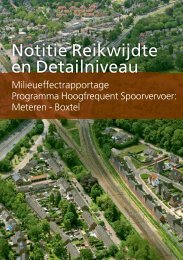Network Statement 2014 - ProRail
Network Statement 2014 - ProRail
Network Statement 2014 - ProRail
- No tags were found...
You also want an ePaper? Increase the reach of your titles
YUMPU automatically turns print PDFs into web optimized ePapers that Google loves.
TermCapacity AgreementCentrally controlledareaCross-overDangerous goodsDefectDisruptionEffective platformlengthERTMSDefinitionA capacity agreement is an access agreement only laying down the capacity to whichthe titleholder has a right, without giving any right to access and use of the railwayinfrastructure.Notes:A capacity agreement can be concluded with a party that is authorised by law toconclude an Access Agreement (e.g. a province granting transport concessions, or ashipper), but which does not have an operating licence.A centrally controlled area is an area within the railway network in which the relationshipbetween route control and track occupation, as well as the operation of individualinfrastructural elements and route control can be monitored from a central location.A cross-over is a facility to switch tracks on an open track by means of (at least two setsof) points.Notes:An example of a crossover is the Infrastructural Facility for Maintenance, which istreated as a train-path point in the scheduling process.Dangerous goods are substances that by virtue of their properties can, even in smallquantities, constitute a hazard for humans, animals or the environment, as referred to inthe Carriage of Dangerous Goods Act.A functionality of the railway infrastructure that is not working (properly).A disruption is a deviation from the timetable above a set standard value. Three types ofdisruptions can be distinguished:1. Delays equal to or larger than the operating incident standard.2. Cancellation for which no normal train service order has been submitted.3. Diversion for which no normal train service order has been submitted.Notes:See Section 23 Paragraph 1 Rail Traffic DecreeThe maximum uninterrupted link for the platform along which a train must stop undernormal circumstances for the boarding and alighting of passengers, taking anappropriate stop tolerance into account. Normal operations means the absence ofinterrupted operations (namely normal radiation, functioning signals, all systems functionproperly).ERTMS is the European standardised safety system for train traffic.Notes:See also ETCS and GSM-RERTMS comprises 3 levels1. Point-to-point train safety system with fixed blocks, and conventional train detection.This is practically identical to ATC-NG in terms of functionality.2. Cabin signalling based on radio-communication, conventional train detection, fixedblocks.3. Cabin signalling based on radio-communication, the train reports its own position,fixed or moving blocks.ETCSETCS is an integral part of ERTMS and concerns the signalling, both along the trackand in the cabin.Exceptional Transport Exceptional transport is the transport of a consignment whose dimensions, weight orwagon type call for exceptional technical or operational measures. Transport regulationsare a precondition for exceptional transport.GSM-RGSM-R is the wireless telecommunications network for the rail sector.Notes:GSM-R is used as means of communication both for voice (drive and traffic controller)and data (between the fixed and mobile safety systems).KPIA KPI (Key Performance Indicator) is a variable used to analyse a specific operationalperformance. It is a management instrument.Locally controlled area A locally controlled area is an area of the railway network, within which the operation ofindividual infrastructural elements and route control take place under the supervision ofa traffic controller with minimum authority.appendix 2 Definitions<strong>Network</strong> <strong>Statement</strong> <strong>2014</strong> Combined <strong>Network</strong> - version 1.0 dated 9 January 2013 page 88



